ISSN ONLINE(2319-8753)PRINT(2347-6710)
ISSN ONLINE(2319-8753)PRINT(2347-6710)
C. Anbumeenakshi1, T.R.Vijaybabu1 and M.R.Thansekhar2
|
| Related article at Pubmed, Scholar Google |
Visit for more related articles at International Journal of Innovative Research in Science, Engineering and Technology
Recent advances in semiconductor technology have led to the significant increase in power densities encountered in microelectronic equipment. The traditional cooling by air is not sufficient for high heat fluxes, and other means of thermal management must be considered. Among these, cooling by single phase liquids through micro channels is one of the promising directions. The thermal efficiency of micro channelbased heat sinks relies on uniform fluid flow distribution between channels. The shape of the inlet header of the micro channel heat sink plays a vital role in the distribution of fluid through channels. In this an experimental investigation has been carried out with a micro channel setup having 25 numbers of rectangular channels of 0.42 mm width, 4.2 mm depth and 100 mm length with two different types of headers namely rectangular, and trapezoidal. From the experimental results it was found that micro channel with trapezoidal header gives less flow mal distribution when compared to rectangular header.
Keywords |
| Micro channel, Header, Mal distribution |
INTRODUCTION |
| With the rapid development of very large-scale integration technology (VLSI) and Micro-Electro Mechanical Systems (MEMS),the application of micro channel heat sinks is drawing more attention as the most compact and efficient method of transferring heat from a power source to a fluid. These micro channel heat sinks, as one of the basic devices in microfluidic system, can be broadly applied to the cooling electronic devices, automotive heat exchangers, laser process equipments, and aerospace technology. A Micro channel heat sink first proposed by Tuckerman and pease (1) has advantages over conventional heat sink such as higher heat dissipation, smaller size and volume per heat load, lower coolant requirement and lower operational cost, etc. |
| P. Gunasegaran et al [2] the effect of geometrical parameters on water flow and heat transfer characteristics in micro channels is numerically investigated. |
| Flow mal distribution depends on several factors such as heat exchanger geometry (mechanical design, channel and header geometry and dimensions, manufacturing tolerances or imperfections), operating conditions (such as flow velocity changes along the headers, fluid viscosity, and multiphase flow) .Jimmy C.K. Tong et al [3] The focus of this investigation is to identify strategies whose application is capable of perfecting manifold design to achieve the same rate of mass outflow through each of the exit ports of a distribution manifold. Lu et al carried out a study on flow and heat transfer characteristics for the multi channel cold-plates by simulation. The flow mal distribution and non-uniformity of temperature field for five inlet configurations are clearly examined and demonstrated in the simulations. Ming Chang Lu et al [4] carried out a study on flow and heat transfer characteristics for the multi channel coldplates by simulation. The flow mal distribution and nonuniformity of temperature field for five inlet configurations are clearly examined and demonstrated in the simulations. Tong et al. [5] numerically examined the flow distribution in multiple micro tubes for three different header geometries like linearly tapered distribution manifold, concave down contoured distribution manifold and concave up contoured distribution manifold assuming uniform velocity at header inlet. Header with linear taper was found to give better flow uniformity. Pan et al.[6]carried out numerical study of velocity distribution in rectangular micro channels and have reported that in order to achieve a uniform flow distribution, micro channel depth, width and pitch should be made as small as possible and also the channel length should be large. Reiyu et al. [7] carried out numerical simulation on the fluid flow and heat transfer in micro channel heat sinks .According to the inlet / outlet arrangements, performance of heat sink were studied. Based on the results from the study, it is suggested that better heat sink performance can be achieved when the coolant is supplied and collected vertically .S.G. kandlikar et al. [8] carried out the CFD simulation for different header configurations namely, circular and tapered cross-section headers were carried out. Severe mal distribution was found for the header with circular cross-section whereas the flow through the channels was nearly uniform in the case of tapered header configuration. A numerical study of flow in rectangular micro channels was presented by Kumaraguruparan et al [9] and was reported that recirculation near the upstream of the inlet header causes flow mal distribution. Compared to numerical study, literature on experimental investigation in micro channel is limited. Wang et al. [10, 11] experimentally investigated the flow in multiple parallel tubes of 3mm diameter with different header designs. Conventional rectangular header was found to produce very high degree of mal distribution. The flow uniformity among branched micro channels depends largely on geometry of the manifold. Thus the header design plays a major role in providing uniform flow through all the channels. Various research works has carried out to analyze this mal distribution by varying the dimensions of micro channel, geometrical shapes of the channels, number of channels, fluid flow inlet location still research is needed to properly identify the causes for the mal distribution. In this it is aimed to carry out an experimental analysis to find a suitable header shape which minimizes the mal distribution effect when the fluid flows through the multiple channels. |
EXPERIMENTAL SETUP AND MEASUREMENT PROCEDURE |
| In general a channel is termed as a micro channel, if the hydraulic diameter lies less than a mm. This experimental set up consists of a micro channel with 25 numbers of rectangular channels machined by wire electric discharge machining process. The header is the part of the micro channel from where the inlet fluid is distributed to the channels. In this a trapezoidal and rectangular shaped header are used. |
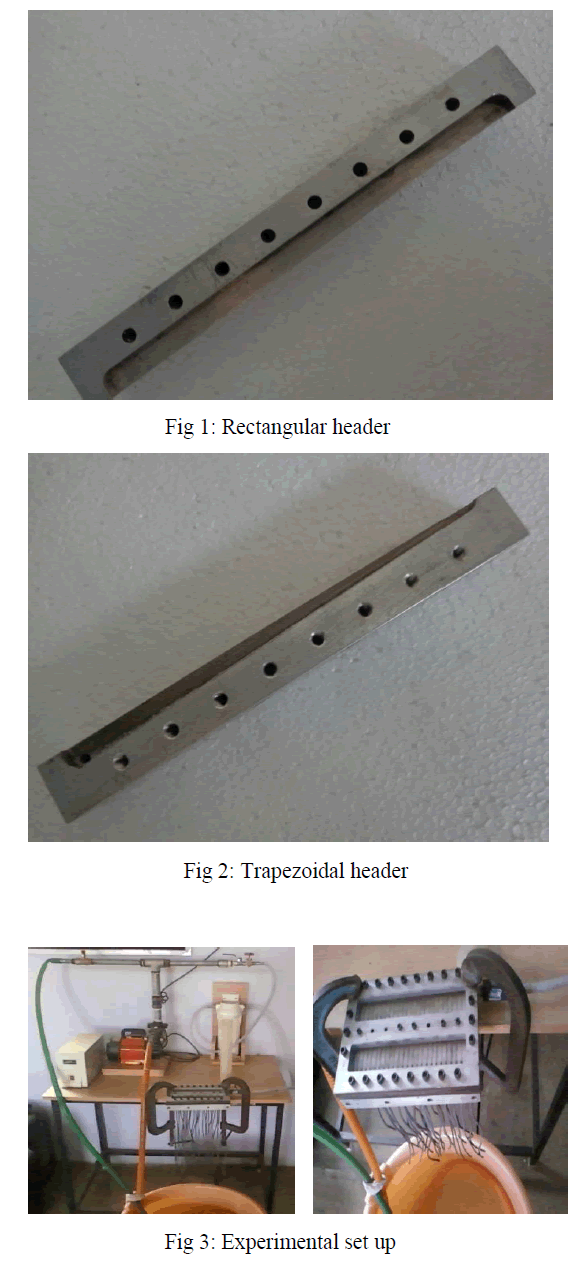 |
| In this trapezoidal and rectangular header with inlet flow arrangement is machined by CNC milling process, and the header and the micro channel were bolted. For each channel of this set up, the width and depth have been measured using machine vision system. |
| Deionized water is used as a working fluid. To visualize the flow arrangement the top of the surface is covered with an acrylic sheet and to maintain a proper balancing forces a mild steel cover is placed on the sheet. A 0.5 H.P. self priming centrifugal pump is used to supply the water to the channel and a filter of 0.5 microns is used to remove the impurities in the water before it is sent to the channel. The experimental set up is shown in fig 3. |
| Preliminary inspection was carried out and the setup is switched on and when the flow is stabilized, the water from each channel is collected with the measuring jar for 3 min, and the mass of the water is measured by an electronic balance. |
| Experiments were carried out with two types of header with inlet flow arrangement with three different flow rates. The reading taken from each channel shows some variations and comparison was made by plotting graphs for channel number to the normalized flow rate for trapezoidal header and rectangular header . The normalized flow rate is the ratio of channel flow rate to the average flow rate in each channel. The value lies in the range of zero to one. If the normalized flow rate for a channel shows zero, it means there is no flow. Meanwhile if the value of normalized flow rate is one then that channel flow rate is equal to the average flow rate. It is inferred that channel does not has any mal distribution. If the value lies in between the range there exists some mal distribution and the mean absolute deviation (MAD) has to be found out. The value of Mean Absolute Deviation [MAD] shows the deviation of flow rate. If the MAD is higher then there is more deviation. |
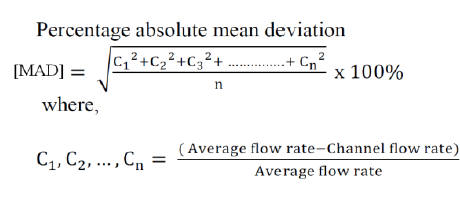 |
RESULTS AND DISCUSSIONS |
| Experiments were carried out with two different shapes of headers and graphs were plotted with channel number and normalised flow rate. Figure 4 and figure5 shows the effect of flow rate for two types of header such as trapezoidal and rectangular. |
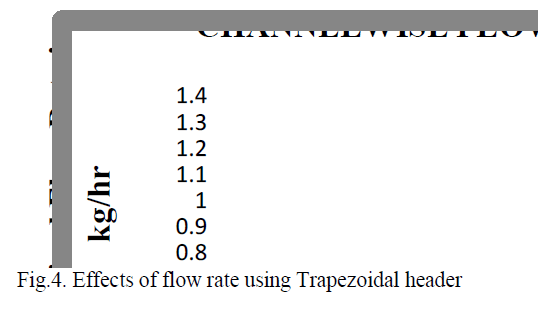 |
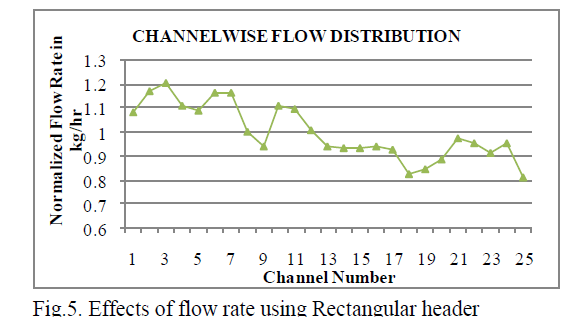 |
| It was found the inlet condition with the inline flow causes the jet effect at the inlet side. The CFD simulation is done for inline flow by using computational fluid dynamics software of gambit and fluent 6.3.26 packages. The results were compared with the experiment value and found it was same as the experimental results. |
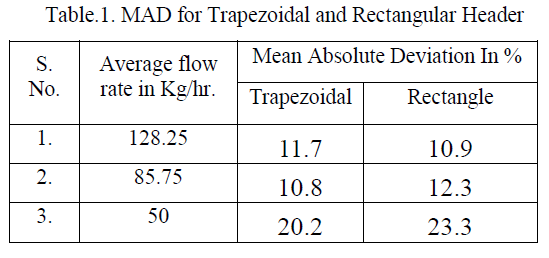 |
| The study indicates that in trapezoidal header and in rectangular header trapezoidal header gives less mal distribution than rectangular header. This is due to the fact that the inline flow inlet condition has the jet effect in inlet side and this contributes to the increase in mal distribution. The numerical investigation for trapezoidal header inline inlet flow condition and for rectangular header inline inlet flow condition was done by using Computational fluid dynamics software and the velocity contours are shown in the figures. |
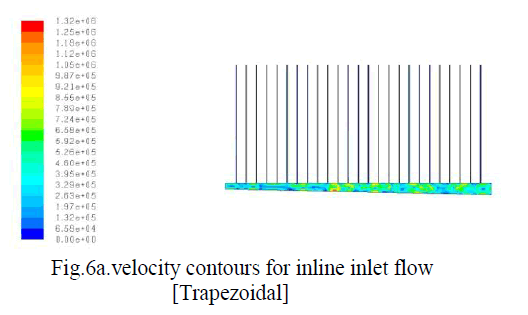 |
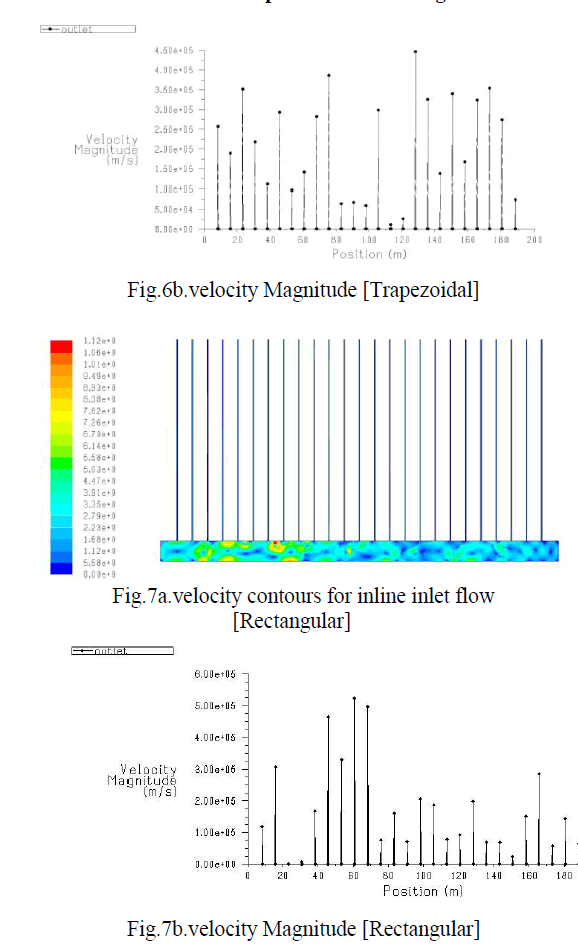 |
CONCLUSION |
| Experiments were carried out with 25 numbers of rectangular micro channels with trapezoidal shaped header and rectangular shaped header. Severe mal distribution was found for the header with inline flow inlet condition of rectangular shaped header. In the inline inlet, there is a jet effect which causes the reverse flow. It was found that recirculation near the upstream of the inlet header causes flow mal distribution and it affects the flow distributions in all the channels. The experiment also indicates that when rate flow reduces then mal distribution increases. |
References |
|